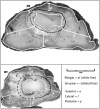The modern abdominoperineal excision: the next challenge after total mesorectal excision
- PMID: 15973104
- PMCID: PMC1357707
- DOI: 10.1097/01.sla.0000167926.60908.15
The modern abdominoperineal excision: the next challenge after total mesorectal excision
Abstract
Objectives: Examine the cause of local recurrence (LR) and patient survival (S) following abdominoperineal resection (APR) and anterior resection (AR) for rectal carcinoma and the effect of introduction of total mesorectal excision (TME) on APR.
Methods: A total of 608 patients underwent surgery for rectal cancer in Leeds from 1986 to 1997. CRM status and follow-up data of local recurrence and patient survival were available for 561 patients, of whom 190 underwent APR (32.4%) and 371 AR (63.3%). Also, a retrospective study of pathologic images of 93 specimens of rectal carcinoma.
Results: Patients undergoing APR had a higher LR and lower survival (LR, 22.3% versus 13.5%, P = 0.002; S, 52.3% versus 65.8%, P = 0.003) than AR. LR free rates were lower in the APR group and cancer specific survival was lowered (LR, 66% versus 77%, log rank P = 0.03; S, 48% versus 59%, log rank P = 0.02). Morphometry: total area of surgically removed tissue outside the muscularis propria was smaller in APR specimens (n = 27) than AR specimens (n = 66) (P < 0.0001). Linear dimensions of transverse slices of tissue containing tumor, median posterior, and lateral measurements were smaller (P < 0.05) in the APR than the AR group. APR specimens with histologically positive CRM (n = 11) had a smaller area of tissue outside the muscularis propria (P = 0.04) compared with the CRM-negative APR specimens (n = 16). Incidence of CRM involvement in the APR group (41%) was higher than in the AR group (12%) (P = 0.006) in the 1997 to 2000 cohort. Similar results (36% and 22%) were found in the 1986 to 1997 cohort (P = 0.002).
Conclusions: Patients treated by APR have a higher rate of CRM involvement, a higher LR, and poorer prognosis than AR. The frequency of CRM involvement for APR has not diminished with TME. CRM involvement in the APR specimens is related to the removal of less tissue at the level of the tumor in an APR. Where possible, a more radical operation should be considered for all low rectal cancer tumors.
Figures




Comment in
-
The site of the tumor, not the type of operation, determines the worse prognosis of the low rectal cancer.Ann Surg. 2006 Aug;244(2):330-1; author reply 331-2. doi: 10.1097/01.sla.0000230007.89561.91. Ann Surg. 2006. PMID: 16858206 Free PMC article. No abstract available.
References
-
- Heald RJ, Husband EM, Ryall RD. The mesorectum in rectal cancer surgery: the clue to pelvic recurrence? Br J Surg. 1982;69:613–616. - PubMed
-
- Heald RJ. Rectal cancer: the surgical options. Eur J Cancer. 1995;31A:1189–1192. - PubMed
-
- Heald RJ, Smedh RK, Kald A, et al. Abdominoperineal excision of the rectum: an endangered operation [Norman Nigro Lectureship]. Dis Colon Rectum. 1997;40:747–751. - PubMed
-
- Martling AL, Holm T, Rutqvist LE, et al. Effect of a surgical training programme on outcome of rectal cancer in the County of Stockholm: Stockholm Colorectal Cancer Study Group, Basingstoke Bowel Cancer Research Project. Lancet. 2000;356:93–96. - PubMed
-
- Wibe A, Moller B, Norstein J, et al. A national strategic change in treatment policy for rectal cancer: implementation of total mesorectal excision as routine treatment in Norway. A national audit. Dis Colon Rectum. 2002;45:857–866. - PubMed
Publication types
MeSH terms
LinkOut - more resources
Full Text Sources
Medical
Research Materials
Miscellaneous

